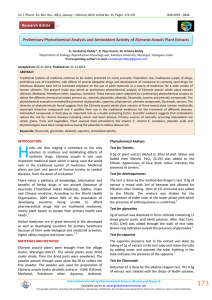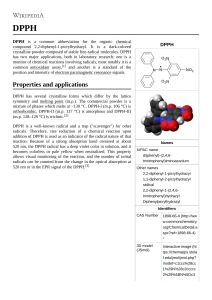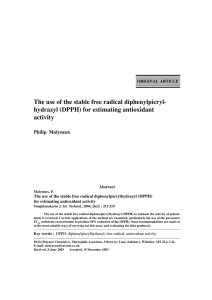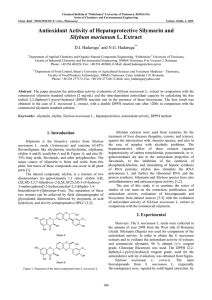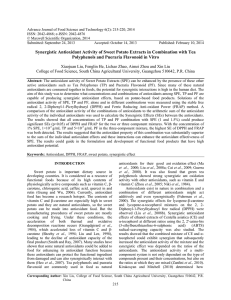Document 13309053
advertisement
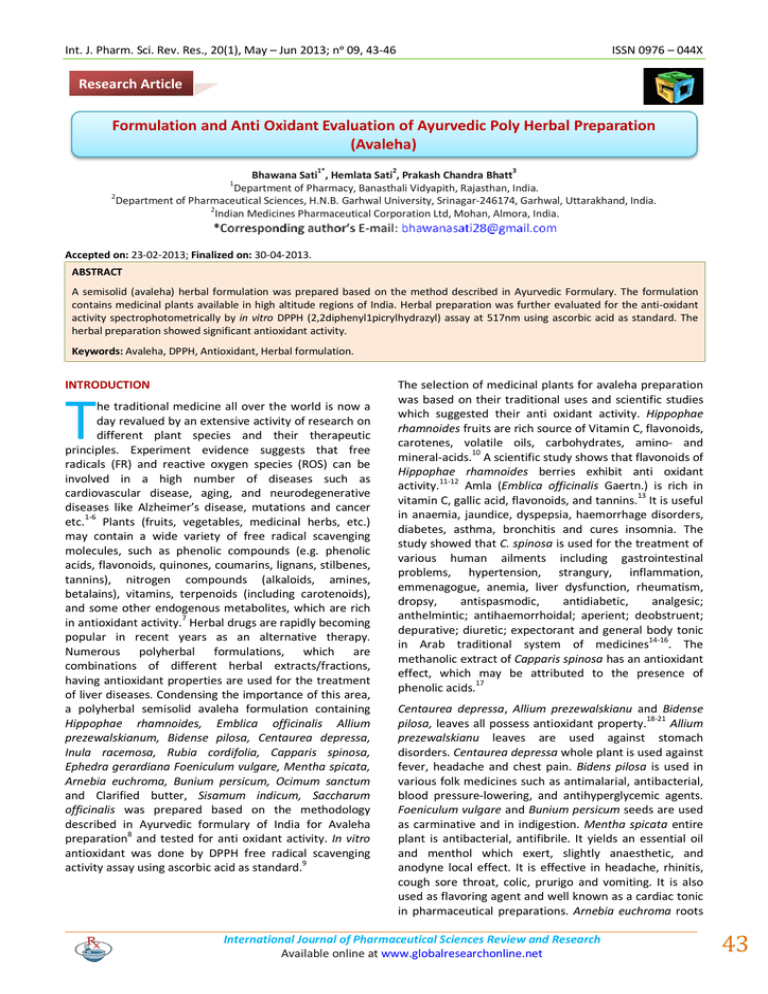
Int. J. Pharm. Sci. Rev. Res., 20(1), May – Jun 2013; nᵒ 09, 43-46 ISSN 0976 – 044X Research Article Formulation and Anti Oxidant Evaluation of Ayurvedic Poly Herbal Preparation (Avaleha) 1* 2 3 Bhawana Sati , Hemlata Sati , Prakash Chandra Bhatt Department of Pharmacy, Banasthali Vidyapith, Rajasthan, India. 2 Department of Pharmaceutical Sciences, H.N.B. Garhwal University, Srinagar-246174, Garhwal, Uttarakhand, India. 2 Indian Medicines Pharmaceutical Corporation Ltd, Mohan, Almora, India. 1 Accepted on: 23-02-2013; Finalized on: 30-04-2013. ABSTRACT A semisolid (avaleha) herbal formulation was prepared based on the method described in Ayurvedic Formulary. The formulation contains medicinal plants available in high altitude regions of India. Herbal preparation was further evaluated for the anti-oxidant activity spectrophotometrically by in vitro DPPH (2,2diphenyl1picrylhydrazyl) assay at 517nm using ascorbic acid as standard. The herbal preparation showed significant antioxidant activity. Keywords: Avaleha, DPPH, Antioxidant, Herbal formulation. INTRODUCTION T he traditional medicine all over the world is now a day revalued by an extensive activity of research on different plant species and their therapeutic principles. Experiment evidence suggests that free radicals (FR) and reactive oxygen species (ROS) can be involved in a high number of diseases such as cardiovascular disease, aging, and neurodegenerative diseases like Alzheimer’s disease, mutations and cancer etc.1-6 Plants (fruits, vegetables, medicinal herbs, etc.) may contain a wide variety of free radical scavenging molecules, such as phenolic compounds (e.g. phenolic acids, flavonoids, quinones, coumarins, lignans, stilbenes, tannins), nitrogen compounds (alkaloids, amines, betalains), vitamins, terpenoids (including carotenoids), and some other endogenous metabolites, which are rich in antioxidant activity.7 Herbal drugs are rapidly becoming popular in recent years as an alternative therapy. Numerous polyherbal formulations, which are combinations of different herbal extracts/fractions, having antioxidant properties are used for the treatment of liver diseases. Condensing the importance of this area, a polyherbal semisolid avaleha formulation containing Hippophae rhamnoides, Emblica officinalis Allium prezewalskianum, Bidense pilosa, Centaurea depressa, Inula racemosa, Rubia cordifolia, Capparis spinosa, Ephedra gerardiana Foeniculum vulgare, Mentha spicata, Arnebia euchroma, Bunium persicum, Ocimum sanctum and Clarified butter, Sisamum indicum, Saccharum officinalis was prepared based on the methodology described in Ayurvedic formulary of India for Avaleha 8 preparation and tested for anti oxidant activity. In vitro antioxidant was done by DPPH free radical scavenging activity assay using ascorbic acid as standard.9 The selection of medicinal plants for avaleha preparation was based on their traditional uses and scientific studies which suggested their anti oxidant activity. Hippophae rhamnoides fruits are rich source of Vitamin C, flavonoids, carotenes, volatile oils, carbohydrates, amino- and mineral-acids.10 A scientific study shows that flavonoids of Hippophae rhamnoides berries exhibit anti oxidant activity.11-12 Amla (Emblica officinalis Gaertn.) is rich in vitamin C, gallic acid, flavonoids, and tannins.13 It is useful in anaemia, jaundice, dyspepsia, haemorrhage disorders, diabetes, asthma, bronchitis and cures insomnia. The study showed that C. spinosa is used for the treatment of various human ailments including gastrointestinal problems, hypertension, strangury, inflammation, emmenagogue, anemia, liver dysfunction, rheumatism, dropsy, antispasmodic, antidiabetic, analgesic; anthelmintic; antihaemorrhoidal; aperient; deobstruent; depurative; diuretic; expectorant and general body tonic 14-16 in Arab traditional system of medicines . The methanolic extract of Capparis spinosa has an antioxidant effect, which may be attributed to the presence of phenolic acids.17 Centaurea depressa, Allium prezewalskianu and Bidense pilosa, leaves all possess antioxidant property.18-21 Allium prezewalskianu leaves are used against stomach disorders. Centaurea depressa whole plant is used against fever, headache and chest pain. Bidens pilosa is used in various folk medicines such as antimalarial, antibacterial, blood pressure-lowering, and antihyperglycemic agents. Foeniculum vulgare and Bunium persicum seeds are used as carminative and in indigestion. Mentha spicata entire plant is antibacterial, antifibrile. It yields an essential oil and menthol which exert, slightly anaesthetic, and anodyne local effect. It is effective in headache, rhinitis, cough sore throat, colic, prurigo and vomiting. It is also used as flavoring agent and well known as a cardiac tonic in pharmaceutical preparations. Arnebia euchroma roots International Journal of Pharmaceutical Sciences Review and Research Available online at www.globalresearchonline.net 43 Int. J. Pharm. Sci. Rev. Res., 20(1), May – Jun 2013; nᵒ 09, 43-46 are used as anti microbial, anti-inflammatory, blood purifier, cold cough, pulmonary problems and hair problems. The root is antipyretic, used in the treatment of measles, mild constipation, burns, frostbite, eczema, dermatitis etc. The root contains alkannin, shikonin, an antitumour and bactericidal compound.22 Ephedra gerardiana roots, stems and branches are considered as antiasthmatic tonic, diuretic, febrifuge, cardiotonic, diaphoretic and vasodilator. Alkaloid called "Ephedrine” helps in controlling asthma. It is widely used for acute muscular and bronchial asthma. The plant also has antiviral effects, particularly against influenza. A decoction of the stems and roots is used to treat rheumatism and syphilis. Inula racemosa roots act as antiseptic, anti-bacterial, anti-fungal, anti-inflammatory, analgesic and mild diuretic. It is used in the treatment of contagious fevers, heart disease bronchial asthma, indigestion, flatulence and inanorexia. Externally, the paste of roots is used effectively, in dressing the wounds and ulcers as the herb possesses antiseptic property and also used to boost the appetite. Rubia cordifolia roots are credited with tonic, antiseptic and deobstruent properties. They are used in rheumatism, and used against stomach and urinary disorders. Ocimum sanctum plant is used as stomachic, anthelmintic, antipyretic, diaphoretic, expectorant, carminative, stimulant and pectoral and also used in the treatment of cold cough, fever, malaria, catarrh, bronchitis and gastric disorders. It also lowers blood sugar levels and its powder is used for mouth ulcers. Sisseme(Til) oil is used for cooking and has medicinal properties.23-25 ISSN 0976 – 044X MATERIALS AND METHODS The formulation was prepared based on the methodology described for avaleha preparation in Ayurvedic Formulary 8 of India. Avaleha is a semi-solid preparation of drugs, prepared with addition of jaggery, sugar or sugar-candy and boiled with prescribed juices or decoction. Collection of material Dried leaves of Allium prezewalskianum, Bidense pilosa, Centaurea depressa, dried roots of Capparis spinosa and fruit pulp of Hippophae rhamnoides and Emblica officinalis were purchased from Indo Herb Uttarakhand. Dried roots of Inula racemosa, Rubia cordifolia and dried stems of Ephedra gerardiana were purchased from Kumaoun Chemicals Uttarakhand. Preparation of Avaleha Formulation 100 gm fruit pulp of amla & 150 gm fruit pulp of Sea buck thorn was mixed with equal portions of pure Sesame oil & Ghee (65gm:65gm). The mixture was fried till it was converted into oily paste. 2 gm of crushed leaves, 1.5gm small pieces of roots and 3.5gm small pieces of stems were boiled in100ml of water until the volume reduced to 25 ml quantity. The decoction was filtered and boiled with sugar until the preparation became sticky. The oily paste was then mixed into it with constant stirring under heated condition so that proper mixing of the ingredients takes place. The preparation was then cooled. When the preparation temperature reached to 30-35°C, the fine mixture of aromatic ingredients was added and mixed thoroughly till homogenize mixture was formed. The ingredients and their quantity taken for Avaleha formulation are presented in table 1. Table 1: The ingredients and quantity taken for Avaleha Formulation Sl. Common Name Botanical Name Parts Used Quantity taken in formulation (in gm) 1 Seabuck thorn Hippophae rhamnoides Fruit pulp 150 2 Amla Emblica officinalis Fruit pulp 100 3 Ghee pure Clarified butter Whole 16.5 4 Sisseme(Til) oil Sisamum indicum Seed oil 16.5 5 Pushkarmool Inula racemosa Root 1.5 6 Manjistha Rubia cordifolia Root 1.5 7 Wild garlic Allium prezewalskianum Leaves 2.0 8 Local wild Tea Bidense pilosa Leaves 2.0 9 Vashakha Centaurea depressa Leaves 2.0 10 Caper bush Capparis spinosa Root 1.5 11 Somlata Ephedra gerardiana Stem 3.5 12 Saunf Foeniculum vulgare Seed Powder 0.1 13 Mint Mentha spicata Leaves Powder 0.1 14 Rattanjot Arnebia euchroma Root powder 0.3 15 Kala Zeera Bunium persicum Seed Powder 0.1 16 Tulsi Ocimum sanctum Leaves Powder 0.1 17 Sugar Saccharum officinalis Sugar Crystal 250 International Journal of Pharmaceutical Sciences Review and Research Available online at www.globalresearchonline.net 44 Int. J. Pharm. Sci. Rev. Res., 20(1), May – Jun 2013; nᵒ 09, 43-46 Antioxidant Activity Preparation of Methanolic extract of Herbal Preparation Herbal preparation (25 g) was macerated with 300 ml of n-hexane for 24 hr. to remove fats and waxes and then supernatant was decanted. Solid mass was macerated with 300 ml of methanol for 24 hr. The methanolic fraction was dried under reduced pressure. Preparation of Solutions Sample Stock solution The dried extract was dissolved in methanol to a final concentration of 100 µg/mL. From stock solution 2 mL, 4 mL, 6 mL, 8 mL and 10 mL of the solution were taken in five test tubes and serially diluted, final volume of each test tube was made up to 10mL whose concentration was then 20 µg/mL, 40 µg/mL, 60 µg/mL, 80 µg/mL and 100 µg/mL respectively. Ascorbic acid was used as a reference standard and dissolved in distilled water to make the stock solution with the same concentration (100 µg/mL) of extract. The different concentrations of standard (20, 40, 60, 80, 100 µg/mL) were prepared. 100 µM (3.95 mg) DPPH solution was prepared in methanol. ISSN 0976 – 044X increases and the more potent the antioxidant activity of the extract. The percentage of DPPH scavenging activity of methanolic extract of herbal preparation was presented in Table 2. The methanolic extract of herbal preparation exhibited a maximum DPPH scavenging activity of 68.20% at 100 µg/ml whereas for Ascorbic acid (standard) was found to be 84.89 % at 100 µg/ml. The IC50values of the methanolic extract of herbal preparation and Ascorbic acid were 60.59 µg/ml and 41.57 µg/ml respectively. Table 2: DPPH scavenging activity of methanolic extract of herbal preparation Concentration (µg/ml) Evaluation of Free Radical Scavenging Activity 2 ml of the DPPH solution was mixed with 2 ml of sample solution and standard solution separately. These solution mixtures were kept in dark for 30 min and Absorbance was measured in 517nm using spectrophotometer. Methanol (2ml) with 2ml DPPH solution was used as control. Control sample was prepared containing the same volume without any extract and reference ascorbic acid. Methanol was used as blank. The Absorbance was recorded and % inhibition was calculated using the formula. Percent (%) inhibition of DPPH activity = A-B/A×100 Where A= Absorbance of the control B= Absorbance of the sample. Constructed a plot between concentration vs % reduction in absorbance of DPPH and calculated the IC50 IC50 is the concentration of the sample required to scavenge 50% of DPPH free radicals. RESULTS AND DISCUSSION DPPH Assay: (2, 2diphenyl1picrylhydrazyl) The scavenging reaction between (DPPH) and an antioxidant (H‐A) can be written as (DPPH) + (H‐A) → DPPH‐H + (A) (Purple) (Yellow) Antioxidants react with DPPH, a stable free radical (purple colour) which was reduced to DPPH‐H (colourless) and as consequence the absorbance was decreased from the DPPH radical to the DPPH‐H form. Hence, the more rapidly the absorbance decreases, the % of inhibition DPPH Radical Scavenging Activity (% inhibition) Methanolic Extract of herbal formulation Ascorbic Acid 20 27.52 38.81 40 38.31 48.12 60 49.52 62.51 80 58.12 75.23 100 68.20 84.89 IC 50 60.59µg/ml 41.57 µg/ml CONCLUSION The results obtained in the study indicate that the formulation shows significant anti oxidant activity. This signifies that combination of herbs can make a good anti oxidant herbal formulation, which can be used for the treatment of many diseases associated with free radicals generation. However, more detailed pre-clinical and clinical evidences are required to establish its potency. REFERENCES 1. Ames B, Micronutrients prevent cancer and delay aging, Toxicol. Lett., 102, 1998, 5-18. 2. Cox DA, Cohen ML, Effects of oxidized low density lipoprotein on vascular contraction and relaxation, Pharmacol. Rev., 48, 1996, 3-9. 3. Finkel T, Holbrook NJ, Oxidants, oxidative stress and the biology of ageing, Nature, 408, 2000,239-247. 4. Harman D, Free radical theory of aging, increasing the functional life span, Ann. New York Acad. Sci., 717, 1994,1-15. 5. Richards R T, Sharma H M, Free radicals in health and disease, Indian J. Clin. Pract., 2, 1991,15-26. 6. Niwa Y, Effect of Maharishi 4 and Maharishi 5 on inflammatory mediators with special reference to their free radical scavenging effect, J. Clin. Pract, 1, 1991, 2327. 7. Zheng W, Wang SY, Antioxidant activity and phenolic compounds in selected herbs, J. Agr. Food Chem., 49, 2001, 5165-5170. International Journal of Pharmaceutical Sciences Review and Research Available online at www.globalresearchonline.net 45 Int. J. Pharm. Sci. Rev. Res., 20(1), May – Jun 2013; nᵒ 09, 43-46 8. The Ayurvedic Formulary of India, Part 1, 1st ed, Ministry of Health and Family Welfare Department of Indian System of medicine and Homeopathy,Government of India, Awleh and Paka, 1976, 31-48. 9. Vani T, Rajini M, Sarkar S, Shishoo C J, Antioxidant properties of the Ayurvedic formulation-Triphala and its constituents, Int. J. Pharm., 35, 1997, 313-317. 10. Sabir SM, Maqsood H, Hayat I, Khan MQ, Khaliq A, Elemental and nutritional analysis of seabuck thorn (Hippophae rhamnoides ssp. turkestanica) berries of Pakistani origin, J. Med. Food., 8, 2005, 518-522. 11. Geetha S, Ram MS, Sharma SK, Ilavazhagan G, Banerjee PK, Sawhney RC, Cytoprotective and antioxidant activity of seabuckthorn (Hippophae rhamnoides L.) flavones against tert-butyl hydroperoxide-induced cytotoxicity in lymphocytes, J Med Food. 12(1), 2009, 151-158. 12. Chaman S, Syed NIH, Danish Z, Khan FZ, Phytochemical analysis, antioxidant and antibacterial effects of sea buckthorn berries, Pak. J. Pharm. Sci., 24(3),2011, 345351. 13. Chen KH, Lin BR, Chien CT, Ho CH, Emblica officinalis Gaertn. attentuates N-nitrosodiethylamine-induced apoptosis, autophagy, and inflammation in rat livers, 14(78), 2011, 746-755. 14. Inocencio C, Alcaraz F, Calderón F, Obón C, Rivera D, The use of floral characters in Capparis sect. Capparis' to determine the botanical and geographical origin of capers, European Food Res.Technol (Springer), 214(4), 2002, 335339. 15. Lemhadri A, Mohamed E, Thierry S, Remy B, Antihyperglycaemic and Anti-obesity Effects of Capparis spinosa and Chamaemelum nobile Aqueous Extracts in HFD Mice. American J. Pharmacol. Toxicol., 2(3), 2007, 106-110. ISSN 0976 – 044X 16. Eddouks M, Lemhadri A, Michel JB, Caraway and caper: Potential antihyperglycaemic plants in diabetic rats, J. Ethnopharmacol, 94, 2004, 143-148. 17. Germano MP, DePasquale RT, D´Angelo V, et al, Evaluation of extracts and isolated fraction from Capparis spinosa L. buds as an antioxidant source, Journal of Agricultural and Food Chemistry, 50(5), 2002, 1168-1171. 18. Ballabh B, Chaurasia OP, Traditional medicinal plants of cold desert Ladakh—Used in treatment of cold, cough and fever, Journal of Ethnopharmacology 112, 2007, 341–349. 19. Hosseinimehr SJ, Pourmorad F, Shahabimajd N, Shahrbandy K, Hosseinzadeh R, In vitro antioxidant activity of Polygonium hyrcanicum, Centaurea depressa, Sambucus ebulus, Mentha spicata and Phytolacca Americana, Pak J Biol Sci.,10(4), 2007, 637-640. 20. Kumar GP, Singh SB, Antibacterial and Antioxidant Activities of Ethanol Extracts from Trans Himalayan Medicinal Plants, European Journal of Applied Sciences, 3 (2), 2011, 53-57. 21. Kviecinski MR, Felipe KB, Correia JFG, Ferreira EA, Rossi MH, Gatti FDM, Filho DW, Pedrosa RC, Brazilian Bidens pilosa Linne yields fraction containing quercetin-derived flavonoid with free radical scavenger activity and hepatoprotective effects, Libyan J Med., 6, 2011, doi: 10.3402/ljm.v6i0.5651. 22. Shen CC, Syu WJ, Li SY, Lin CH, Lee GH, Sun CM, Antimicrobial activities of naphthazarins from Arnebia euchroma, J Nat Prod., 65(12), 1857-1862. 23. http://motherherbs.com. 24. http://ayushveda.com. 25. http://himalaya health care.com Source of Support: Nil, Conflict of Interest: None. International Journal of Pharmaceutical Sciences Review and Research Available online at www.globalresearchonline.net 46

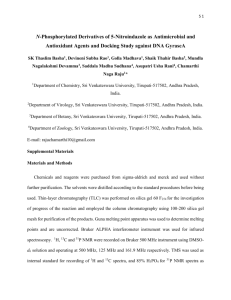
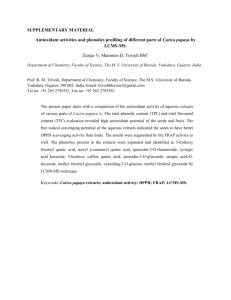



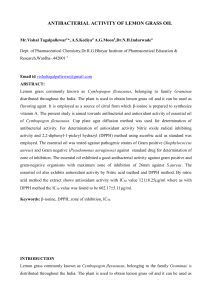
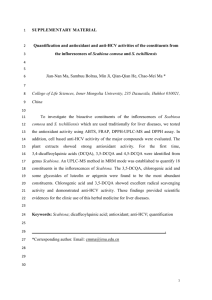

![benzo[d] isoxazole: In vitro Antimicrobial and Antioxidant activity](http://s3.studylib.net/store/data/007006684_1-684f7b1d721ca4abfe74cc96e54598b2-300x300.png)
